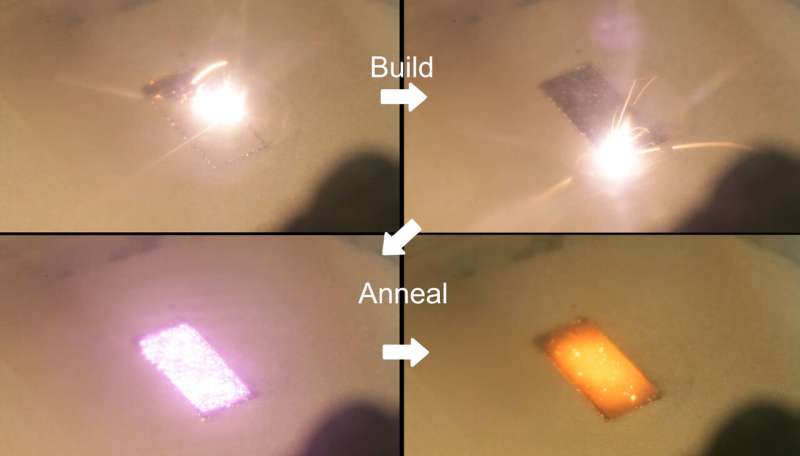High-powered laser diodes can reduce residual stress in metal 3-D printed parts

In 3-D printing, residual stress can build up in parts during the printing process due to the expansion of heated material and contraction of cold material, generating forces that can distort the part and cause cracks that can weaken or tear a part to pieces, especially in metals.
Researchers at Lawrence Livermore National Laboratory (LLNL) and the University of California, Davis are addressing the problem by using laser diodes—high-powered lasers borrowed from technology created for LLNL's National Ignition Facility (NIF)—to rapidly heat the printed layers during a build. The new technique, described in a paper released online by the journal Additive Manufacturing, resulted in the reduction of effective residual stress in metal 3-D-printed test parts by 90 percent, by enabling researchers to reduce temperature gradient (the difference between hot and cold extremes) and control cooling rates.
"In metals it's really hard to overcome these stresses," said the paper's lead author John Roehling. "There's been a lot of work on trying to do things like changing the scanning strategy to redistribute the residual stresses, but basically our approach was to get rid of them as we're building the part, so you don't have any of those problems. Using this approach, we can effectively get rid of residual stresses to the point that you don't have part failures during the build anymore."
For the purpose of the study, LLNL engineer and co-lead author Will Smith built small, bridge-like structures from 316L stainless steel using the laser powder bed fusion (LPBF) process. He let each layer solidify before illuminating their surfaces with the diodes, initially at full power and immediately ramping down the intensity over a period of 20 seconds. The result was akin to putting the part in a furnace after each layer, as surface temperatures reached about 1,000 degrees Centigrade (1,832 degrees Fahrenheit).
The finished parts, with their thick legs and thin overhang section, allowed researchers to measure how much residual stress was relieved by cutting one of the legs off and analyzing how much the weaker overhang section moved. When the diodes were used, the bridge didn't deflect anymore, researchers said.
"Building the parts was similar to how a normal metal 3-D printer works, but the novel part of our machine is we use a secondary laser that projects over a larger area and that post-heats the part afterwards—it raises the temperature up rapidly and slowly cools it down in a controlled fashion," Smith said. "When we used the diodes, we saw that there was a trend in the reduction of residual stress, and it compared to what is done traditionally by annealing a part in an oven afterwards. This was a good result, and it was promising as to how effective our technique was."
The approach is an offshoot of a previous project in which laser diodes, developed to smooth out lasers in NIF, were used to 3-D-print entire metal layers in one shot. It bests other common methods for reducing residual stress in metal parts, such as altering the scanning strategy or using a heated build plate, Roehling said. Because the approach heats from the top, there's no limit on how tall the parts can be.
Researchers will next perform a more in-depth study, turning their attention to increasing the number of layers per heating cycle to see if they can reduce residual stress to the same degree, attempt more complex parts and use more quantitative techniques to gain a more in-depth understanding of the process.
"This technology is something that could be scaled up, because right now we're projecting over a relatively small area and there's still a lot of room for improvement," Smith said. "By adding more of the diode lasers, we could add more heating area if someone wanted to integrate this into a system with a larger printing area."
More importantly, Roehling said, researchers will explore controlling phase transformations in titanium alloy (Ti64). Typically, when building with Ti64, phase transformation causes the metal to become extremely brittle, causing parts to crack. If researchers could avoid the transformation by cooling the part slowly, it could make the material ductile enough to meet aerospace standards, Roehling said, adding that preliminary results are promising.
More information: John D. Roehling et al. Reducing residual stress by selective large-area diode surface heating during laser powder bed fusion additive manufacturing, Additive Manufacturing (2019). DOI: 10.1016/j.addma.2019.05.009
Provided by Lawrence Livermore National Laboratory




















